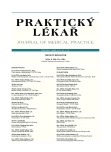Classification of techniques to cope with craving
Authors:
K. Nešpor; O. Matanelli; G. Pekárková; P. Gregor
Authors‘ workplace:
Oddělení léčby závislostí – muži, Psychiatrická léčebna Bohnice, Praha, Ředitel: MUDr. Martin Hollý
Published in:
Prakt. Lék. 2011; 91(12): 703-706
Category:
Reviews
Overview
Craving is a typical symptom of addictive diseases. There are several important features of craving:
- It is usually caused by identifiable stimuli (triggers).
- It is accompanied by the subjective and objective symptoms of stress.
- It has a powerful motivating effect and worsens the self-control of addictive behavior.
- Craving is associated with the temporary impairment of cognitive functions and poor decision-making.
Key words:
craving, addictive diseases, therapy.
Sources
1. Echeburúa, E., Gómez, M., Freixa, M. Cognitive-behavioural treatment of pathological gambling in individuals with chronic schizophrenia: A pilot study. Behav. Res. Ther. 2011, 49(11), p. 808-814.
2. Elibero, A., Janse Van Rensburg, K., Drobes, D.J. Acute effects of aerobic exercise and hatha yoga on craving to smoke. Nicotine Tob. Res. 2011 first published online August 17, 2011 doi:10.1093/ntr/ntr163.
3. Field, M., Munafò, M.R., Franken, I.H. A meta-analytic investigation of the relationship between attentional bias and subjective craving in substance abuse. Psychol. Bull. 2009, 135(4), p. 589-607.
4. Filbey, F.M., Schacht, J.P., Myers, U.S. et al. Marijuana craving in the brain. Proc. Natl. Acad. Sci. USA 2009, 106(31), p. 13016-13021.
5. Higley, A.E., Crane, N.A., Spadoni, A.D. et al. Craving in response to stress induction in a human laboratory paradigm predicts treatment outcome in alcohol-dependent individuals. Psychopharmacology (Berl). 2011, 218(1), p. 121-129.
6. Kilts, C.D., Gross, R.E., Ely, T.D., Drexler, K.P. The neural correlates of cue-induced craving in cocaine-dependent women. Am. J. Psychiatry 2004, 161(2), p. 233-241.
7. Knäuper, B., Pillay, R., Lacaille, J. et al. Replacing craving imagery with alternative pleasant imagery reduces craving intensity. Appetite 2011, 57(1), p. 173-178.
8. Larimer, M.E., Palmer, R.S., Marlatt, G.A. Relapse prevention an overview of Marlatt’s cognitive-behavioral model. Alcohol Res. Health 1999; 23(2), p. 151-160.
9. Maas, L.C., Lukas, S.E., Kaufman, M.J. et al. Functional magnetic resonance imaging of human brain activation during cue-induced cocaine craving. Am. J. Psychiatry 1998, 155, p. 124-126.
10. May, J., Andrade, J., Panabokke, N., Kavanagh, D. Visuospatial tasks suppress craving for cigarettes. Behav. Res. Ther. 2010, 48(6), p. 476-485.
11. McHugh, R.K., Murray, H.W., Hearon, B.A. et al. Attentional bias and craving in smokers: the impact of a single attentional training session. Nicotine Tob. Res. 2010, 12(12), p. 1261-1264.
12. Morgenstern, M., Isensee, B., Sargent, J.D., Hanewinkel, R. Exposure to alcohol advertising and teen drinking. Prev. Med. 2011, 52(2), p. 146-151.
13. Nees, F., Diener, C., Smolka, M.N., Flor, H. The role of context in the processing of alcohol-relevant cues. Addict. Biol. 2011 Jul 25. doi: 10.1111/j.1369-1600.2011.00347.x. [Epub ahead of print]
14. Nešpor, K., Csémy, L. Bažení (craving). Společný rys mnoha závislostí a jeho zvládání. Praha: Sportpropag, 1999; 76 s.
15. Nešpor, K. Léčivá moc smíchu. 4. rozšířené vydání. Praha: Vyšehrad 2010; 174 s.
16. Nešpor, K. Návykové chování a závislost. 4. aktualizované vydání. Praha: Portál 2011; 176 s.
17. Nešpor, K. Uvolněně a s přehledem. Relaxace a meditace pro moderního člověka. Praha: Grada 1998; s. 96. Volně dostupné na www.drnespor.eu.
18. Parks, G.A., Marlatt, A. Relapse Prevention Therapy: A Cognitive-Behavioral Approach. The National. Psychologis.t 2000; 9(5). Dostupné na http://nationalpsychologist.com/2000/09/relapse-prevention-therapy-a-cognitive-behavioral-approach/10491.html
19. Rogojanski, J., Vettese, L.C., Antony, M.M. Coping with cigarette cravings: comparison of suppression versus mindfulness-based strategies. Mindfulness 2011, 2(1), p. 14-26.
20. Rogojanski, J., Vettese, L.C., Antony, M.M. Role of sensitivity to anxiety symptoms in responsiveness to mindfulness versus suppression strategies for coping with smoking cravings. J. Clin. Psychol. 2011, 67(4), p. 439-445.
21. Rohsenow, D.J., Monti, P.M. Does urge to drink predict relapse after treatment? Alcohol Res. Health 1999 23(3), p. 225-232.
22. Říčan, P. (2011): Osobní sdělení.
Labels
General practitioner for children and adolescents General practitioner for adultsArticle was published in
General Practitioner

2011 Issue 12
Most read in this issue
- Ulcerogenic corticosteroids – the persisting myth among Czech doctors
- Classification of techniques to cope with craving
- Deficit Fluid Volume rating by nurses according to the diagnostic cues of nursing diagnosis
- Interstitial lung diseases in questions and answers
